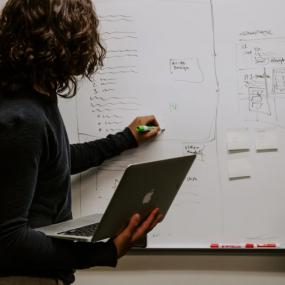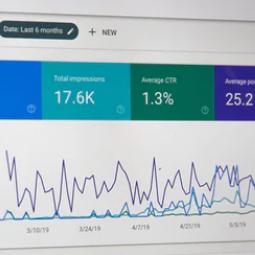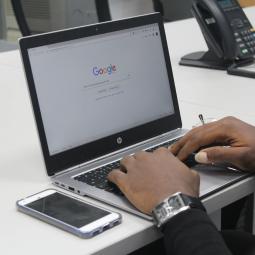When it comes to your organisation's online presence, your website can be considered your ‘digital reception’. Websites are one of the main ways you can maintain your online presence and how people will discover you online. It’s the place where you can control what is published, unlike social media which needs moderation.
Using a website, you will be able to provide better communications to your clients, describe and promote your services in your local area and expand your online service offering.
However, designing and setting up a website takes time and planning. Not only that, you will also have to consider how it will be updated on a regular basis and maintained.
If you’re just starting with your website or only have a basic site, here are some common questions (and answers).
How much does it cost to have a website?
Like a building, the basic things you’ll need for a website are an address, called a “domain name” and a place to build your website. Most of the time, someone else will rent you space to “host” your website on their server. So, the two basic costs are your domain name and hosting.
Domain costs: There are different types of domains (e.g. .com and .net). Most commonly for Australian businesses, a domain name ending with .com.au is used. The .com.au domains require an ABN and also let users know that you are based in Australia. Many not-for-profits choose .org.au as this denotes an organisation rather than .com which is short for "commercial".
Hosting costs: If you lease a building for your organisation, you know that it needs to have the right features to support your needs. There are basics such as water and electricity but you may also need extras that suit your organisation. Different website hosts will charge different rates depending on what you need such as storage space, bandwidth and other technology your website needs.
On top of these costs, you will also need to consider:
- who is going to create your website (DIY or professional contractor)?
- who is going to maintain the technical aspects of your website?
- who will update the website and its content on a regular basis?
- who will optimise your website to make sure it can be found in search engines? (ie. SEO)
Domain and hosting can be purchased from the same provider or separate providers, and many DIY website builders now include domain name purchase and hosting as a package (e.g. GoDaddy, SiteGround or Google Cloud).
How do you create a website?
There are two main considerations when creating a website – web design (how it looks), web development (how it works).
Depending on your investment, in-house skills and available time, you will have a few options:
Option 1: DIY with a website builder
If you’re after a basic website that can be customised with a low-level of tech skills and don’t mind paying a small monthly fee, a service such as Wix or Squarespace can set you up with the basics.
Costs:
- usually a small monthly fee ($5-$20 per month); slightly more to add your own domain name
- hosting is generally included at no extra cost
- additional costs if you need advanced features like an online shop or client login area
Pros:
- many start out as a ‘free’ options to test if it’s right for you
- quick to set up
- only a low level of technical knowledge needed
- service provider looks after technical maintenance
- easy to design with pre-built themes
- easy to update yourself - they all have an inbuilt content editor.
Cons:
- limited upgradability if you want to add any non-standard features (e.g. client logins, shopping cart).
- API and plug-in options can be limited, so check closely if you think you will want to plug in features like a donation capability.
- design options are more limited, but the templates are increasingly varied and aesthetically pleasing.
Option 2: Self-hosted website
If you have some extra capacity in your organisation and would like to manage the hosting yourself. This means renting space from a web host and then installing the software you need yourself. There are many packages available for you through most web hosts. It’s best to shop around to find what you need.
Then with hosting managed, a content management system, such as WordPress, Joomba or Drupal will provide you the flexibility to create your website and publish your content.
Costs:
- hosting costs depends on your needs (e.g. bandwidth, space)
- you are required to manage your own software updates and security measures to prevent the risk of a cyber breach
Pros:
- self-hosted websites provide maximum flexibility for design and to install and remove features
- only pay for what you need
Cons:
- requires in-house developers
- set up and maintenance can take longer
Option 3: Outsourcing web design and web development
If you don’t have the in-house skills or resources to achieve the results you’re after with a DIY option, you may want to outsource the start-up of your website. Once established, you can then make ongoing content updates.
The cost of working with a web designer, web developer or an agency will depend on a number of factors such as their technical experience, the quality of their work, their customer service level and the complexity of the work you require.
Costs:
- can be significantly higher depending on time, quality of work and requirements
Pros:
- professional support
- expert advice
- software updates and security managed on your behalf
- potentially access other professional services (e.g, SEO, advertising, customisation).
Cons:
- costs
- inability to make edits if you don’t have in-house resourcing.
Other website considerations
When creating your website, there a few other considerations to take into account. This can usually be done by thinking about who is going to use your website and how they will be accessing it. Here are a few pointers:
- User experience – you should test your website with the people who will use it to make sure it's intuitive and meets their needs. You can do this easily by identifying the most important tasks people will undertake on your site, and then asking a few people (preferably those who don't have a vested interest in the site) to complete the tasks. You'll soon see what's not clear to users and what needs to change.
- Accessibility – you should make sure your website meets accessibility standards as 1 in 5 people have a disability that may mean they have different needs when accessing your website. This includes colour blindness, or being partially sighted.
- Responsive design – your website must be easy to use on a mobile device. Responsive design means the same design will resize depending on the screen it is being viewed on.
- Cross-browser support – each web browser (eg Safari, Chrome, Internet Explorer) is slightly different so you will need to make sure it works on all of them.
What’s next?
While it may be tempting to select the cheapest option, it’s worth understanding that a good online presence can be beneficial for your organisation and should be seen as an investment for long-term gain.
Once you have your plans for your website happening, it’s worth taking time to see where else your organisation may be listed and claim those listings!





Status message
Thanks for rating this guide.